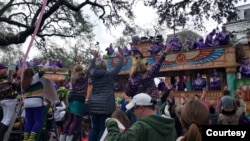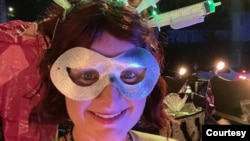“It feels like an entire city was pent-up in a cage, but now the doors are finally open and we’re free,” New Orleans resident Michelle Gaynor told VOA. She was explaining her emotions as the city resumes its annual Mardi Gras celebration a year after festivities were canceled because of the coronavirus pandemic.
For a city that defines itself by large, community-wide parties — including the nearly two-month-long carnival season culminating in Mardi Gras — last year’s cancellation was a heartbreaking, though necessary decision. That’s true for the hundreds of thousands of residents who look forward to the events each year, but also for the local businesses that depend on tourists drawn to the celebrations.
Now, as the omicron variant has weakened, the Crescent City has returned to life just in time for this year’s Mardi Gras on Tuesday, March 1.
“This is such a joyful time right now,” Gaynor explained. “It’s like an explosion of happiness after so much sadness. It’s been a tough couple of years with the pandemic, but there’s a hope we’re finally coming out of it.”
A lost year
A wall of sound from marching bands cuts through the crisp, springtime air. Masked revelers in elaborate multi-tiered floats throw beads to the throngs of parade goers in brightly colored costumes up and down oak tree-lined avenues. Friends and families gather, adults with beers in hand no matter the time of day, while all check their slice of the traditional king cake to see who gets the prize, a baby figurine that, according to local lore, makes the recipient “king/queen for the day.”
These are just some of the unique customs of the New Orleans Mardi Gras. “It’s like nothing you’ll find anywhere else in the world,” explained Jennifer Samuels, owner of the beloved King Cake Hub, a one-stop shop for buying king cakes, the city’s most popular seasonal food. “And it’s nothing like the debauchery you see depicted in television and movies. What Mardi Gras actually is, is a citywide block party. It’s a chance to reconnect with friends and to celebrate together.”
Samuels said that’s what she feels has made the pandemic especially difficult for New Orleanians. “I’m sure isolation has been challenging for everyone, but so much about what it means to be a New Orleanian involves being with each other and celebrating as a city.”
The last time Mardi Gras was able to proceed as usual was in 2020. That was before the first COVID-19 cases were reported in the region. Weeks later, however, New Orleans was declared one of the earliest hotspots of the pandemic with many experts blaming Carnival season for massive transmission of the virus.
The following year, as coronavirus case numbers remained stubbornly high, city officials canceled all larger Mardi Gras gatherings. “We all knew it was the right move,” said Vanessa Van Vrancken, an avid Mardi Gras reveler and former queen of the parading group, Krewe of Hermes, “but it was still depressing.”
The decision to close bars and to cancel parades, balls, and other large gatherings didn’t just hurt New Orleanians’ hearts and spirits. It also wreaked havoc on the city’s economy. The hospitality and tourism industry employs 72,000 workers in the New Orleans metropolitan area, or 12% of the work force.
MaryBeth Romig, a spokesperson for the tourism-focused marketing firm New Orleans & Company, said residents felt the sting of a missed Mardi Gras and the estimated 1.4 million visitors that come with it.
“There’s a lot of spending that goes on during the Mardi Gras festivities,” Romig explained. “People are frequenting restaurants for their dinners, bars for their beers, bakeries for their king cakes, and the list goes on. It’s a lot of ancillary spending that is vital for keeping businesses open and people in jobs.”
Return to life
This year the city will once again benefit from that spending. Romig says. While the season’s tourism numbers aren’t completely back to their pre-pandemic numbers, they are close. During the weekend before Fat Tuesday, for example, downtown hotels have reported an average of a 90% occupancy rate.
“And it’s not just good for business, it gives the city hope, too,” said Jacques Couvillon, a manager at popular restaurant Cochon Butcher. “It feels like the city is rebounding.”
The sight of tens of thousands of people cheering and reveling along the long parade route is proof that New Orleans is returning to life.
Most share Couvillon’s view that this is something to feel hopeful about. Some, however, fear it’s too much too soon during a pandemic that has ebbed but not disappeared, and are choosing to stay away. Tanya Gulliver-Garcia loves Carnival season. She’s in a Mardi Gras parading krewe and also volunteers as many as 120 hours each year at a first aid tent along the parade route.
This year, however, she has decided to stay away. “I looked at some of the photos from earlier parades and I see people are out there not wearing a mask. People think they’re invincible, but I take care of my disabled and medically fragile nephew each week. If I gave him COVID, I would be devastated.”
Some regular visitors are staying away, as well. Susanne Goudswaard and her husband live in Ontario, Canada, and, before last year’s suspension of festivities, traveled to New Orleans for Mardi Gras each year for the past two decades.
“We love everything about this city. The food, the music, the people and their zest for life. The architecture and the history. It breaks our heart that we won’t be coming to Mardi Gras this year, but with coronavirus and its variants, we decided it would be safer to celebrate from home.”
The return of Mardi Gras
Some experts have warned that the city could see a bump in coronavirus cases after Mardi Gras, but that it will likely be less severe than past waves.
Brian Moore, programming coordinator at the Historic New Orleans Collection, is responsible for planning many of the nonprofit organization’s educational events throughout the year, including during carnival season. He said they have consulted with an epidemiologist to ensure they’ll be as safe as possible.
“He told us we should probably cancel any events we have planned after Mardi Gras because there will probably be a two-week spike,” Moore recalled. “Basically, for people who are out celebrating but aren’t vaccinated or haven’t gotten sick already, they’ll catch it. But we were told that shouldn’t last too long.”
Most New Orleanians feel the city is ready to take the risk. Nearly 80% of the local population has at least one dose of the coronavirus vaccine while almost 70% are fully vaccinated.
“We’ve been careful and cautious, and I think we’ve done what we need to do,” said Samuels, who was getting her costume ready to ride in a parade. “We’ll continue to wear masks indoors as long as we’re asked, but we also need to find that balance and try to get back to normal. This city is ready to celebrate.”
Tawanda Carter, a member of a dance troupe that performs during carnival season agrees.
“It feels like we’re emerging out of a tunnel and can see the sun shining again, like Spring is finally here. New Orleans is going to celebrate this moment like we always have — together, as a community,” she said.















